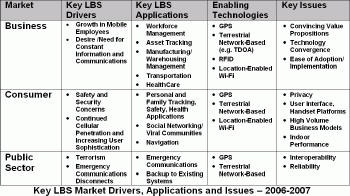Why didn’t this happen earlier? The reasons for the slow takeoff of LBS, and why things are different now, boil down to the following:
- Then: Immature positioning technologies. Now: Cellular carriers have finally stabilized their network platforms and position determination technologies, with A-GPS and TDOA in the U.S., for example.
- Then: Multiple network platforms and slow network speeds. Now: 2.5G on a single network platform for nearly all carriers, with 3G on the way.
- Then: Weak handsets in terms of memory, graphics display capabilities and user interface mechanisms. Now: Dramatic feature upgrades, even for low-end handsets.
- Then: Carrier preoccupation with other initiatives: network platform migration, wireless E911, wireless number portability, 802.11x/Wi-Fi. Now: Renewed focus on new revenue sources.
- Then: Immature customer base unaccustomed to dealing with anything beyond voice. Now: Wireless penetration into nearly all significant demographic segments, including children and seniors, and across the entire economic spectrum in nearly all regions of the globe, with increasing user familiarity and sophistication in most segments with new wireless applications. Growing familiarity with location technology (e.g. GPS) across wide swaths of wireless users.
- Then: Confusion on part of location application developers as to what and how to design LBS applications. Now: Creation and stabilization of standards, protocols and application developer programs and tools for both platforms/middleware and handsets, such as Java, MLP, OpenLS, J2ME (GSM) and BREW (CDMA).
- Then: Underestimation of the complexities involved in putting together an integrated end-to-end location business. Now: Hard lessons learned are being applied so that ALL dimensions of an LBS business are appropriately addressed: value proposition articulation, business model selection, user interface design, development tools, partnership strategies, marketing strategies, operational and support execution, etc.
- Then: Mass market approach – Poor value propositions, assumption that one location application fits all, little design innovation. Now: An appreciation for AND execution towards individual LBS segments, particularly in articulating clear value propositions, with product packaging focused on delivering that value and marketing to match.
Other issues still need to be resolved. Difficulties in location tracking in indoor environments continue to bedevil certain applications. Privacy concerns are, if anything, even more acute then they were a few years ago, yet the technical, legal and political mechanisms for dealing with them have progressed only slightly.
That said, improvements have been made on enough fronts that we are finally on the cusp of an LBS breakout. 2005 was the year of LBS’ reemergence, with carriers such as Sprint Nextel and Vodafone demonstrating a renewed commitment to location based services. 2006 will be the year of new application introduction, as other carriers and a proliferation of new developers begin to bring their applications online. 2007 will see subscriptions to LBS applications begin an explosive growth phase as familiarity with LBS applications penetrates a critical mass of market segments and those segments, which will see the benefits of adoption enjoyed by their peers or competitors.
 |
Looking forward beyond 2006 and 2007, LBS stakeholders need to broaden their view beyond just GPS/Network-based location technologies and associated applications, and anticipate its convergence with Radio Frequency Identification (RFID) and location-enabled Wi-Fi. Advances in the price and performance of both offer the opportunity for complementary and in some cases competing location-based services, as well as opening the door for location to be applied to markets not accessible before, such as health care.
In addition, LBS designers need to anticipate the next generation of user interface devices coming down the road. If there is a key remaining technical weakness in the LBS technology value chain it is the multitude of user devices that initiate and receive LBS information. Even more important is that the devices and user interfaces we have are still inherently limiting by forcing the user to physically type LBS requests and receive information on a small screen. These are annoying at best and dangerous at worst for many types of location services. LBS designers need to anticipate a likely shakeout of sorts in user devices (LBS iPod anyone?) and continued advances in voice recognition, LBS data to voice conversion and delivery, and others will enable truly easy-to-use applications, These will be unhindered by the physical and technology limitations that exist in today’s handsets.
We’ve come a long way since the “dark” LBS years earlier this decade, and are finally on the cusp of the opportunities that many of us have been working and waiting for over many years. Let’s make the most of it!